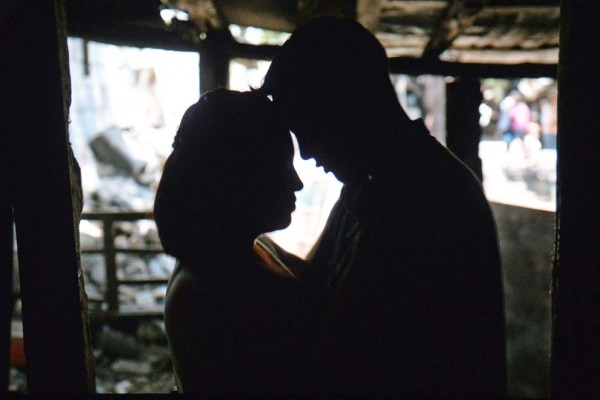-
THE DOVE AND THE WOLF/LA PALOMA Y EL LOPO (Carlos Lenin 2019)
CARLOS LENIN: THE DOVE AND THE WOLF/LA PALOMA Y EL LOBO (2019)

A downbeat ballet of working class life doomed by cartel violence
The Dove and the Wolf is set in a grimy small town assailed by cartel violence where those on the fringes must be contented with low-level urban labor, factory work. The main characters have little education and no prospects and live in primitive, run-down projects.
This situation dominates everything. Personalities barely emerge, and seem muffled. This is primarily a mood piece. One should not take too seriously the film's actions. The original, very self conscious young director, Carlos Lenin, hasn't gotten that far. He has a location and a situation and a sense of style and mission. This whole film could be seen as a ballet - albeit a static one: the fixed-position, low-lit, distinctly toned cinematography by Diego Tenorio is actually pretty striking. The two principle "dancers," circle around each other, approaching and avoiding. Soon it becomes clear that the boyfriend, Lobo (Armando Hernandez), feels deeply guilty about something unspeakable he's implicated in that indirectly involves his girlfriend, Paloma ((Paloma Petra). It will not be a surprise to learn later that it's something to do with gang violence. Little by little it comes out. That's all we've got for action.
The misery Lenin steeps his "story" in is so intense and stylized as to almost cross over to the other side into a kind of beauty. Grime, graffiti, miserable rooms, depressing low-life factories, shabby clothes are so extreme as to appear the self-conscious set for that same ballet. Figures in the foreground are often in darkness and become silhouettes, set off attractively by figures or objects behind and around them, and always the framing is symmetrical. The camera is static, and sometimes far off. Scenes are framed by the walls of a room or a building, centered, narrowing down the sphere of the action and heightening its sense of confinement but also making it more pictorial. There is a distinctive color scheme too: turquoise and pink and pale earth colors predominate, with brown. Everything is self-conscious. It's an aestheticizing of poverty and hopelessness, artistic miserabilism.
There is a catch in the ballet analogy, because this Paloma and Lobo are not handsome, fit, and energetic like ballet dancers but like typical working class Mexican types are a bit chubby and carry themselves in a stoop-shouldered and downcast manner. In a job interview Paloma appears a shy, innocent, hesitant girl. Here she timidly smiles. Lobo, whose supervisor, seen off in the distance, refuses to pay him for the next two weeks, seems so depressed and humiliated in every single scene it seems exaggerated. But Lenin's debut film and Hernandez's performance show intense conviction and artistic control. The look of the film is unique and original. There is much to be endured and little to be enjoyed here, but someone is doing exactly what they wanted to do.
The Dove and the Wolf/La paloma y el lobo debuted at Locarno in Aug. 2020 in the Filmmakers of the Present section winning the Swatch Art Peace Hotel Award; it also showed at Los Cabos, and in the delayed pandemic virtual New Directors/New Films series, where it was screened for this review. At the Ariels, Mexico's "Oscars," the film won best actor, best cinematography and best first film.
Last edited by Chris Knipp; 12-18-2020 at 10:53 PM.
 Posting Permissions
Posting Permissions
- You may not post new threads
- You may not post replies
- You may not post attachments
- You may not edit your posts
-
Forum Rules





 Reply With Quote
Reply With Quote
Bookmarks